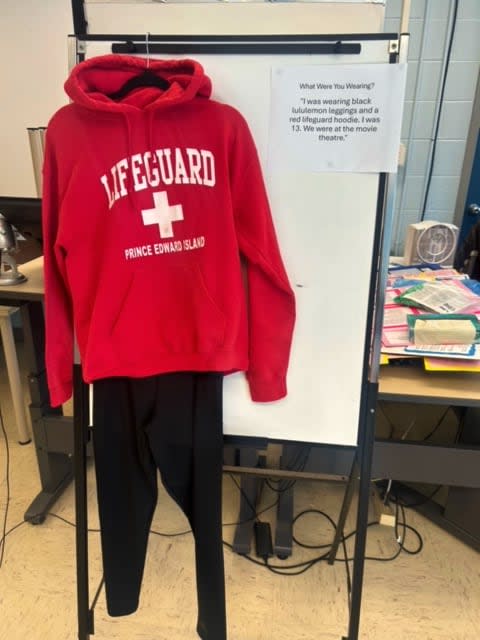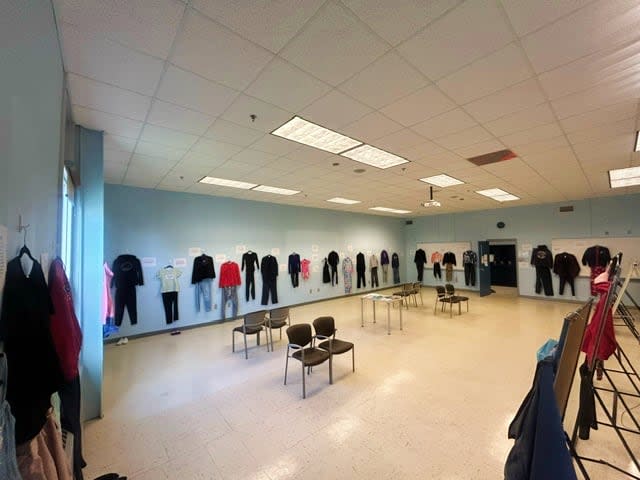What Were You Wearing display confronts biases around sexual assault, says organizer

Children's T-shirts, oversized hoodies and rain jackets.
Those are some of the items of clothing on display as part of the What Were You Wearing campaign at NSCC's Lunenburg campus in Bridgewater.
Mia Fournier-White, the president of the campus's student association, has set up the display of nearly 40 outfits reflecting what people were wearing when they were assaulted.
In an interview with Maritime Noon, Fournier-White said each of the outfits was submitted anonymously. Each submission is accompanied by a description of the outfit, using clothing on loan from a local Value Village.

Information about support and resources is also available at the exhibit. (Mia Fournier-White)
"Most of them are not the clothes that people would expect," she said. "Your unconscious bias might go, 'Oh yeah, they must have been wearing something really revealing that you would typically wear downtown.'"
It's those biases that Fournier-White hopes to combat with the display.
She's a survivor of sexual assault. Her own submission is on display.
"I think that it really shows that it really does not matter what clothes you have on during any type of sexual assault," Fournier-White said, "whether it's harassment or as bad as it could possibly get."
Dawn Ferris, the executive director of Autumn House in Amherst, echoed that sentiment.
"People think that they did something wrong and it led to their rape, that they were wearing something wrong, they were acting inappropriate or they were drinking too much," said Ferris. "It's not got anything to do with the outfit, the location, the situation."
Autumn House offers services to clients who have been abused in intimate partner relationships and Ferris said some of the organization's clients also face that scrutiny. Her advice is to encourage survivors to seek out the support they need.
"Reach out to organizations ... know that you're not alone," Ferris added. "You don't have to carry the stigma and shame."
Exhibit runs until Friday
The What Were You Wearing movement is an international one, Fournier-White said, and was named after one of the main questions survivors are often asked after their assaults.
She hopes the display inspires different questions.
"We should be asking, 'Where would you like to go from here? How are you feeling? What type of supports would you like?'" Fournier-White said.

The clothes will be on display until Friday. (Mia Fournier-White)
Information about some of the support and resources are also available at the exhibit.
She also said gathering submissions and putting the display together has been therapeutic for her. So far, she said the feedback has been positive and she's been asked to continue the campaign for the years to come.
"It doesn't matter if you're female, male, non-binary, what size you are," Fournier-White said. "It doesn't matter what pieces of fabric you're wearing on your body at the time of your incident, ever."
The display will be up until Friday.
For anyone who has been sexually assaulted, there is support available through crisis lines and local support services via this Government of Canada website or the Ending Violence Association of Canada database. If you're in immediate danger or fear for your safety or that of others around you, please call 911.
MORE TOP STORIES


